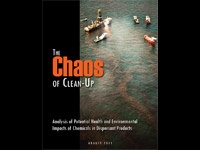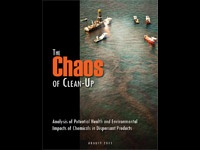Report Sheds Light on Chemicals in Oil Dispersants
Originally posted last month by Earthjustice Development Writer David Lawlor. In coordination with Earthjustice we are posting as another example of the critical need for Congress to pass the Safe Chemical Act of 2011.
 Pop quiz: Nearly 2 million gallons of chemicals are about to be dumped into the ocean where they will mix with oil gushing from a blown out well. Do you:
Pop quiz: Nearly 2 million gallons of chemicals are about to be dumped into the ocean where they will mix with oil gushing from a blown out well. Do you:Well, following last year’s Deepwater Horizon oil spill in the Gulf of Mexico, answer D is exactly what happened.
With millions of gallons of oil spurting from the blown-out well, chemical oil dispersants were applied in unprecedented amounts both at the ocean’s surface and underwater at the well head. A report released today by Earthjustice and Toxipedia Consulting Services presents a scientific literature review of chemical ingredients found in dispersants that were eligible for use at the time of the Deepwater Horizon disaster. And the results point to a toxic cocktail of oil and chemicals that threaten humans, wildlife and the environment.
Tell your senator now that we need to pass the Safe Chemicals Act of 2011.
The report, The Chaos of Clean-Up, comes as a result of Earthjustice’s advocacy and litigation, which led to the release of information detailing the chemical ingredients used in oil dispersants. Earthjustice attorney Marianne Engelman Lado, representing the Gulf Restoration Network and the Florida Wildlife Federation, challenged the Environmental Protection Agency in court to reveal all available health and toxicity information concerning oil dispersants. In response, the EPA released an aggregated list of the 57 ingredients eligible for use during oil spill cleanup operations, along with previously withheld health and safety information. The information can be viewed at a special Earthjustice webpage at earthjustice.org/features/the-chaos-of-clean-up.
Toxipedia’s scientific review demonstrates the wide range of potential impacts from exposure to the chemicals found in dispersants. From carcinogens, to endocrine disruptors, to chemicals that are toxic to aquatic organisms, some of the ingredients in oil dispersants are indeed potential hazards.
For instance, of the 57 ingredients: five chemicals are associated with cancer; 33 are associated with skin irritation from rashes to burns; 33 are linked to eye irritation; 11 are or are suspected of being potential respiratory toxins or irritants; 10 are suspected kidney toxins; eight are suspected or known to be toxic to aquatic organisms; and five are suspected to have a moderate acute toxicity to fish.
While revealing some of the potential hazards of dispersants, the report also highlights the lack of knowledge about dispersants and their impacts. Ultimately, the absence of thorough scientific research on dispersants, as well as the lack of public disclosure of each dispersant’s ingredients, hinder efforts to understand the full impacts of dispersant use.
This lack of knowledge is dangerous as the timing of another oil spill cannot be predicted. Dumping potentially toxic chemicals into the ocean without understanding the effects could result in significant harm to marine ecosystems, wildlife, and public health.
The report’s findings call for more research, greater disclosure of the information that is known, comprehensive toxicity testing, establishment of safety criteria for dispersants, and careful selection of the least toxic dispersants for application in oil spill response.
As oil companies continue to accelerate plans to drill in the Arctic and in the Gulf, detailed information about the effects of chemical oil dispersants are more important now than ever. Only with full knowledge about the chemicals being used can government and the public make informed decisions about how to respond to the next oil spill disaster.
Secrecy around the ingredients of dispersants is just another example of how little we know about the chemicals being sold and used every day. Making sure that information about toxics is available is another powerful reason we need congress to pass the Safe Chemicals Act of 2011 that was introduced by Senator Lautenberg. When passed, this landmark legislation will create the foundation for a sound and comprehensive chemicals policy to protect both public health and the environment.
Tell your senator now that we need to pass the Safe Chemicals Act of 2011.




